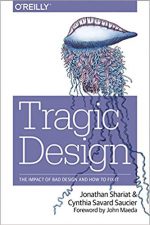Designing for Social Technologies: Responsible Privacy Design
Concerns about negative social consequences can be a barrier to online participation. UX designers have the opportunity and responsibility to design for overcoming this.

Concerns about negative social consequences can be a barrier to online participation. UX designers have the opportunity and responsibility to design for overcoming this.

Tragic Design, by Jonathan Shariat and Cynthia Savard Saucier, reveals how design choices can negatively impact users and provides techniques to avoid harmful design decisions.
As the IoT world continues to expand, researchers need to understand what to take into account when evaluating and improving the design of smart speakers.

When designing healthcare experiences, we need to prove the effectiveness of our solutions as much as we need to consider their desirability, feasibility, and viability.

In this article, the author walks through the process they used to build and roll out a user-centric scorecard to help teams increase UX maturity.

A look into the daily life of UX managers who play a unique role in UX practice.

Cumbersome medical software is a leading cause in physician dissatisfaction and burnout. But that story could change if physicians had a voice-driven virtual medical assistant.
Voice-enabled devices are gaining the ability to mimic human-to-human interactions fairly well. This article outlines some general guidelines to consider when designing voice user interfaces.
UX design teams reaching for low-hanging fruit for MVP products may fall into the trap of focusing on “minimal” to the detriment of “viable.”

Over the past five years, Novo Nordisk has systematically iterated and improved on their UX research processes, increasing the design influence on product development.

User Experience Professionals Association (UXPA) International supports people who research, design, and evaluate the user experience (UX) of products and services.